Zirui Li
Escaping Stability-Plasticity Dilemma in Online Continual Learning for Motion Forecasting via Synergetic Memory Rehearsal
Aug 27, 2025Abstract:Deep neural networks (DNN) have achieved remarkable success in motion forecasting. However, most DNN-based methods suffer from catastrophic forgetting and fail to maintain their performance in previously learned scenarios after adapting to new data. Recent continual learning (CL) studies aim to mitigate this phenomenon by enhancing memory stability of DNN, i.e., the ability to retain learned knowledge. Yet, excessive emphasis on the memory stability often impairs learning plasticity, i.e., the capacity of DNN to acquire new information effectively. To address such stability-plasticity dilemma, this study proposes a novel CL method, synergetic memory rehearsal (SyReM), for DNN-based motion forecasting. SyReM maintains a compact memory buffer to represent learned knowledge. To ensure memory stability, it employs an inequality constraint that limits increments in the average loss over the memory buffer. Synergistically, a selective memory rehearsal mechanism is designed to enhance learning plasticity by selecting samples from the memory buffer that are most similar to recently observed data. This selection is based on an online-measured cosine similarity of loss gradients, ensuring targeted memory rehearsal. Since replayed samples originate from learned scenarios, this memory rehearsal mechanism avoids compromising memory stability. We validate SyReM under an online CL paradigm where training samples from diverse scenarios arrive as a one-pass stream. Experiments on 11 naturalistic driving datasets from INTERACTION demonstrate that, compared to non-CL and CL baselines, SyReM significantly mitigates catastrophic forgetting in past scenarios while improving forecasting accuracy in new ones. The implementation is publicly available at https://github.com/BIT-Jack/SyReM.
Complementary Learning System Empowers Online Continual Learning of Vehicle Motion Forecasting in Smart Cities
Aug 27, 2025Abstract:Artificial intelligence underpins most smart city services, yet deep neural network (DNN) that forecasts vehicle motion still struggle with catastrophic forgetting, the loss of earlier knowledge when models are updated. Conventional fixes enlarge the training set or replay past data, but these strategies incur high data collection costs, sample inefficiently and fail to balance long- and short-term experience, leaving them short of human-like continual learning. Here we introduce Dual-LS, a task-free, online continual learning paradigm for DNN-based motion forecasting that is inspired by the complementary learning system of the human brain. Dual-LS pairs two synergistic memory rehearsal replay mechanisms to accelerate experience retrieval while dynamically coordinating long-term and short-term knowledge representations. Tests on naturalistic data spanning three countries, over 772,000 vehicles and cumulative testing mileage of 11,187 km show that Dual-LS mitigates catastrophic forgetting by up to 74.31\% and reduces computational resource demand by up to 94.02\%, markedly boosting predictive stability in vehicle motion forecasting without inflating data requirements. Meanwhile, it endows DNN-based vehicle motion forecasting with computation efficient and human-like continual learning adaptability fit for smart cities.
Pronunciation Editing for Finnish Speech using Phonetic Posteriorgrams
Jul 02, 2025Abstract:Synthesizing second-language (L2) speech is potentially highly valued for L2 language learning experience and feedback. However, due to the lack of L2 speech synthesis datasets, it is difficult to synthesize L2 speech for low-resourced languages. In this paper, we provide a practical solution for editing native speech to approximate L2 speech and present PPG2Speech, a diffusion-based multispeaker Phonetic-Posteriorgrams-to-Speech model that is capable of editing a single phoneme without text alignment. We use Matcha-TTS's flow-matching decoder as the backbone, transforming Phonetic Posteriorgrams (PPGs) to mel-spectrograms conditioned on external speaker embeddings and pitch. PPG2Speech strengthens the Matcha-TTS's flow-matching decoder with Classifier-free Guidance (CFG) and Sway Sampling. We also propose a new task-specific objective evaluation metric, the Phonetic Aligned Consistency (PAC), between the edited PPGs and the PPGs extracted from the synthetic speech for editing effects. We validate the effectiveness of our method on Finnish, a low-resourced, nearly phonetic language, using approximately 60 hours of data. We conduct objective and subjective evaluations of our approach to compare its naturalness, speaker similarity, and editing effectiveness with TTS-based editing. Our source code is published at https://github.com/aalto-speech/PPG2Speech.
DocMMIR: A Framework for Document Multi-modal Information Retrieval
May 25, 2025Abstract:The rapid advancement of unsupervised representation learning and large-scale pre-trained vision-language models has significantly improved cross-modal retrieval tasks. However, existing multi-modal information retrieval (MMIR) studies lack a comprehensive exploration of document-level retrieval and suffer from the absence of cross-domain datasets at this granularity. To address this limitation, we introduce DocMMIR, a novel multi-modal document retrieval framework designed explicitly to unify diverse document formats and domains, including Wikipedia articles, scientific papers (arXiv), and presentation slides, within a comprehensive retrieval scenario. We construct a large-scale cross-domain multimodal benchmark, comprising 450K samples, which systematically integrates textual and visual information. Our comprehensive experimental analysis reveals substantial limitations in current state-of-the-art MLLMs (CLIP, BLIP2, SigLIP-2, ALIGN) when applied to our tasks, with only CLIP demonstrating reasonable zero-shot performance. Furthermore, we conduct a systematic investigation of training strategies, including cross-modal fusion methods and loss functions, and develop a tailored approach to train CLIP on our benchmark. This results in a +31% improvement in MRR@10 compared to the zero-shot baseline. All our data and code are released in https://github.com/J1mL1/DocMMIR.
InterHub: A Naturalistic Trajectory Dataset with Dense Interaction for Autonomous Driving
Nov 30, 2024



Abstract:The driving interaction-a critical yet complex aspect of daily driving-lies at the core of autonomous driving research. However, real-world driving scenarios sparsely capture rich interaction events, limiting the availability of comprehensive trajectory datasets for this purpose. To address this challenge, we present InterHub, a dense interaction dataset derived by mining interaction events from extensive naturalistic driving records. We employ formal methods to describe and extract multi-agent interaction events, exposing the limitations of existing autonomous driving solutions. Additionally, we introduce a user-friendly toolkit enabling the expansion of InterHub with both public and private data. By unifying, categorizing, and analyzing diverse interaction events, InterHub facilitates cross-comparative studies and large-scale research, thereby advancing the evaluation and development of autonomous driving technologies.
ArrivalNet: Predicting City-wide Bus/Tram Arrival Time with Two-dimensional Temporal Variation Modeling
Oct 17, 2024



Abstract:Accurate arrival time prediction (ATP) of buses and trams plays a crucial role in public transport operations. Current methods focused on modeling one-dimensional temporal information but overlooked the latent periodic information within time series. Moreover, most studies developed algorithms for ATP based on a single or a few routes of public transport, which reduces the transferability of the prediction models and their applicability in public transport management systems. To this end, this paper proposes \textit{ArrivalNet}, a two-dimensional temporal variation-based multi-step ATP for buses and trams. It decomposes the one-dimensional temporal sequence into intra-periodic and inter-periodic variations, which can be recast into two-dimensional tensors (2D blocks). Each row of a tensor contains the time points within a period, and each column involves the time points at the same intra-periodic index across various periods. The transformed 2D blocks in different frequencies have an image-like feature representation that enables effective learning with computer vision backbones (e.g., convolutional neural network). Drawing on the concept of residual neural network, the 2D block module is designed as a basic module for flexible aggregation. Meanwhile, contextual factors like workdays, peak hours, and intersections, are also utilized in the augmented feature representation to improve the performance of prediction. 125 days of public transport data from Dresden were collected for model training and validation. Experimental results show that the root mean square error, mean absolute error, and mean absolute percentage error of the proposed predictor decrease by at least 6.1\%, 14.7\%, and 34.2\% compared with state-of-the-art baseline methods.
Updating Robot Safety Representations Online from Natural Language Feedback
Sep 22, 2024



Abstract:Robots must operate safely when deployed in novel and human-centered environments, like homes. Current safe control approaches typically assume that the safety constraints are known a priori, and thus, the robot can pre-compute a corresponding safety controller. While this may make sense for some safety constraints (e.g., avoiding collision with walls by analyzing a floor plan), other constraints are more complex (e.g., spills), inherently personal, context-dependent, and can only be identified at deployment time when the robot is interacting in a specific environment and with a specific person (e.g., fragile objects, expensive rugs). Here, language provides a flexible mechanism to communicate these evolving safety constraints to the robot. In this work, we use vision language models (VLMs) to interpret language feedback and the robot's image observations to continuously update the robot's representation of safety constraints. With these inferred constraints, we update a Hamilton-Jacobi reachability safety controller online via efficient warm-starting techniques. Through simulation and hardware experiments, we demonstrate the robot's ability to infer and respect language-based safety constraints with the proposed approach.
A Nested Graph Reinforcement Learning-based Decision-making Strategy for Eco-platooning
Aug 14, 2024Abstract:Platooning technology is renowned for its precise vehicle control, traffic flow optimization, and energy efficiency enhancement. However, in large-scale mixed platoons, vehicle heterogeneity and unpredictable traffic conditions lead to virtual bottlenecks. These bottlenecks result in reduced traffic throughput and increased energy consumption within the platoon. To address these challenges, we introduce a decision-making strategy based on nested graph reinforcement learning. This strategy improves collaborative decision-making, ensuring energy efficiency and alleviating congestion. We propose a theory of nested traffic graph representation that maps dynamic interactions between vehicles and platoons in non-Euclidean spaces. By incorporating spatio-temporal weighted graph into a multi-head attention mechanism, we further enhance the model's capacity to process both local and global data. Additionally, we have developed a nested graph reinforcement learning framework to enhance the self-iterative learning capabilities of platooning. Using the I-24 dataset, we designed and conducted comparative algorithm experiments, generalizability testing, and permeability ablation experiments, thereby validating the proposed strategy's effectiveness. Compared to the baseline, our strategy increases throughput by 10% and decreases energy use by 9%. Specifically, increasing the penetration rate of CAVs significantly enhances traffic throughput, though it also increases energy consumption.
QuantumSEA: In-Time Sparse Exploration for Noise Adaptive Quantum Circuits
Jan 10, 2024Abstract:Parameterized Quantum Circuits (PQC) have obtained increasing popularity thanks to their great potential for near-term Noisy Intermediate-Scale Quantum (NISQ) computers. Achieving quantum advantages usually requires a large number of qubits and quantum circuits with enough capacity. However, limited coherence time and massive quantum noises severely constrain the size of quantum circuits that can be executed reliably on real machines. To address these two pain points, we propose QuantumSEA, an in-time sparse exploration for noise-adaptive quantum circuits, aiming to achieve two key objectives: (1) implicit circuits capacity during training - by dynamically exploring the circuit's sparse connectivity and sticking a fixed small number of quantum gates throughout the training which satisfies the coherence time and enjoy light noises, enabling feasible executions on real quantum devices; (2) noise robustness - by jointly optimizing the topology and parameters of quantum circuits under real device noise models. In each update step of sparsity, we leverage the moving average of historical gradients to grow necessary gates and utilize salience-based pruning to eliminate insignificant gates. Extensive experiments are conducted with 7 Quantum Machine Learning (QML) and Variational Quantum Eigensolver (VQE) benchmarks on 6 simulated or real quantum computers, where QuantumSEA consistently surpasses noise-aware search, human-designed, and randomly generated quantum circuit baselines by a clear performance margin. For example, even in the most challenging on-chip training regime, our method establishes state-of-the-art results with only half the number of quantum gates and ~2x time saving of circuit executions. Codes are available at https://github.com/VITA-Group/QuantumSEA.
Spatiotemporal-Linear: Towards Universal Multivariate Time Series Forecasting
Dec 22, 2023Abstract:Within the field of complicated multivariate time series forecasting (TSF), popular techniques frequently rely on intricate deep learning architectures, ranging from transformer-based designs to recurrent neural networks. However, recent findings suggest that simple Linear models can surpass sophisticated constructs on diverse datasets. These models directly map observation to multiple future time steps, thereby minimizing error accumulation in iterative multi-step prediction. Yet, these models fail to incorporate spatial and temporal information within the data, which is critical for capturing patterns and dependencies that drive insightful predictions. This oversight often leads to performance bottlenecks, especially under specific sequence lengths and dataset conditions, preventing their universal application. In response, we introduce the SpatioTemporal-Linear (STL) framework. STL seamlessly integrates time-embedded and spatially-informed bypasses to augment the Linear-based architecture. These extra routes offer a more robust and refined regression to the data, particularly when the amount of observation is limited and the capacity of simple linear layers to capture dependencies declines. Empirical evidence highlights STL's prowess, outpacing both Linear and Transformer benchmarks across varied observation and prediction durations and datasets. Such robustness accentuates its suitability across a spectrum of applications, including but not limited to, traffic trajectory and rare disease progression forecasting. Through this discourse, we not only validate the STL's distinctive capacities to become a more general paradigm in multivariate time-series prediction using deep-learning techniques but also stress the need to tackle data-scarce prediction scenarios for universal application. Code will be made available.
 Add to Chrome
Add to Chrome Add to Firefox
Add to Firefox Add to Edge
Add to Edge